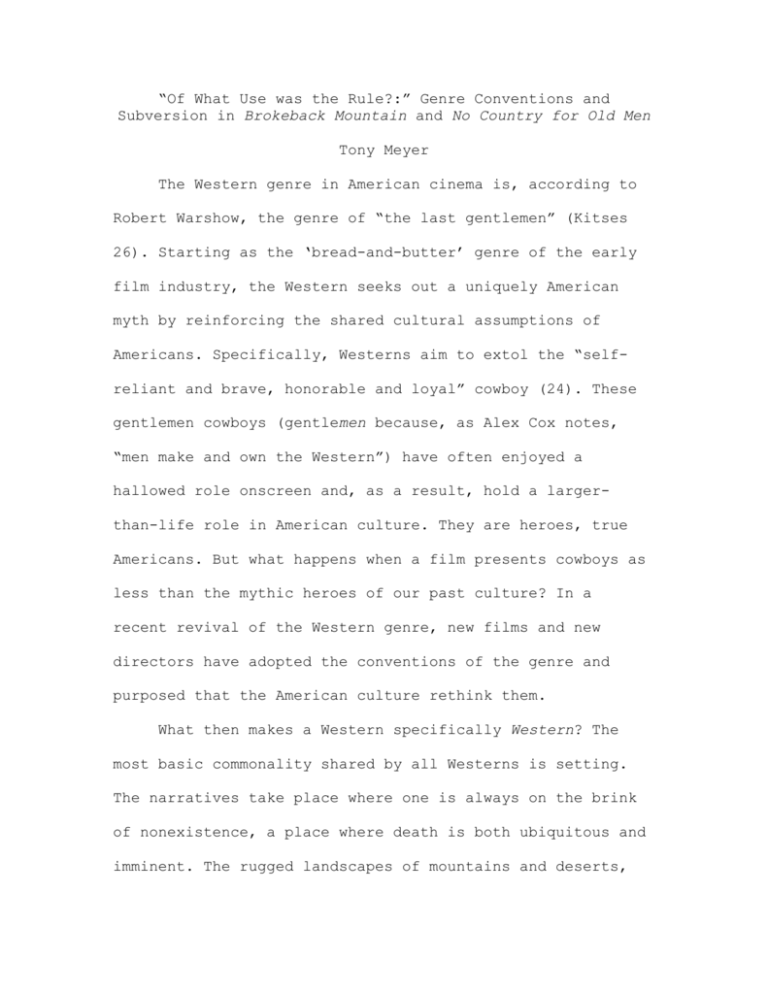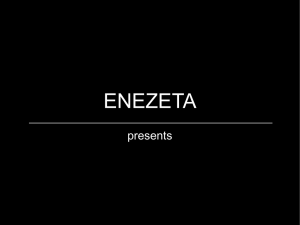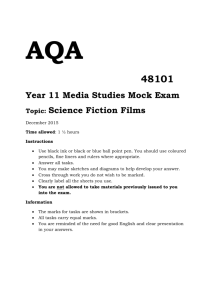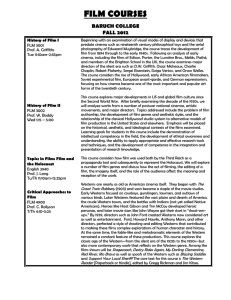Of What Use was the Rule
advertisement

“Of What Use was the Rule?:” Genre Conventions and Subversion in Brokeback Mountain and No Country for Old Men Tony Meyer The Western genre in American cinema is, according to Robert Warshow, the genre of “the last gentlemen” (Kitses 26). Starting as the ‘bread-and-butter’ genre of the early film industry, the Western seeks out a uniquely American myth by reinforcing the shared cultural assumptions of Americans. Specifically, Westerns aim to extol the “selfreliant and brave, honorable and loyal” cowboy (24). These gentlemen cowboys (gentlemen because, as Alex Cox notes, “men make and own the Western”) have often enjoyed a hallowed role onscreen and, as a result, hold a largerthan-life role in American culture. They are heroes, true Americans. But what happens when a film presents cowboys as less than the mythic heroes of our past culture? In a recent revival of the Western genre, new films and new directors have adopted the conventions of the genre and purposed that the American culture rethink them. What then makes a Western specifically Western? The most basic commonality shared by all Westerns is setting. The narratives take place where one is always on the brink of nonexistence, a place where death is both ubiquitous and imminent. The rugged landscapes of mountains and deserts, although erupting with raw beauty, set the stage for the drama of the Western with their desolation. It is a place of “savage joy, offering both ecstasy and torture” (25). The Western setting contrasts with “back East.” The West exists outside civilization, and its heroes are often not so civilized. According to Peter A. French, the JudeoChristian system of values, emblematic of the American East, is antithetical to the West; the Sermon on the Mount literally has no haven in the mountains (14). While Easterners may look for justice in the Second Coming, the concept is too abstract and out of place in the West where one’s death is as close as the next drought, rattlesnake, or rogue gunslinger. The next commonality between Westerns is an emphasis on morality. Although one could argue that all films, like all of literature, are essentially political, and are thus tales of morality, Westerns engage a specific type of morality. John Kekes characterizes the morality of Western films as character morality, measuring a person’s moral worth solely on the merits of the deeds he or she has done (French 25). This type of morality is fundamentally opposed to what Kekes calls choice morality, “an essential component of the popular view, held by [Immanuel] Kant, that moral worth and moral merit can and should be 2 disassociated” (25). So, the traditional moral code of the Western is one that draws a line in the sand: either a character is on the side of justice and egalitarianism or one is one the side of disorder, corruption, and senseless violence. Peter A. French suggests that the moral code of the West essentially operates on a dichotomy of shame versus honor; and, the path of the hero will always be the honorable one (96). This is not to say that the heroes of Westerns cannot enact their morality through violence. On the contrary, since Stagecoach, the Western has found heroes in the fictitious outlaw archetype (Coyne 25). The noble outlaw is a ‘bad good man,’ a gunslinger with a nobility of purpose and a sense of what is right. Finally, all Westerns seek to define what it means to be a hero. This hero is the archetypical Westerner—the Lone Ranger, the Duke, the Man with No Name, or any one of his other countless manifestations. He holds certain values to be true regardless of who he is or what his background might be. Around the time the Western genre was taking root in the American cinematic lexicon, Gene Autry introduced the “Ten Commandments of the Cowboy,” intended to be guidelines for American youth. With some exceptions, this moral code still holds true for Western heroes: the cowboy must not take unfair advantage, must tell the truth, help 3 people in distress, be respectful to women and his parents, be a patriot, etc (Fenin and Everson 21). There have been countless allusions to the cowboy as a type of contemporary vassal who desires a chivalrous lifestyle and noble combat as well. However, the hero in Westerns is not always as clean-cut. The genre makes ample use of the literary antihero; in fact, the antiheros of Westerns are usually more well known than the vassal types. These men are outsiders from the society which they instinctively protect. They retain the noble aspirations of heroes, yet they are not afraid to commit bad acts (e.g. Clint Eastwood’s portrayal of William Munny in The Unforgiven). Westerns revel in the notion of a ‘bad good man.’ In order to help cultivate the definition of the hero, Westerns create the hero’s antithesis in the villains of the genre. These antagonists essentially believe in the opposite values of the heroes: they are not afraid to murder for their own profit, lie, take unfair advantage, act sadistically and unmercifully, etc. While heroes are egalitarian, villains are greedy; heroes are sexually virtuous, and villains are lusty. Inevitably, the hero and the villain are drawn into conflict with each other, a battle of the forces of good and those of evil—a conflict that endeared itself to the American consciousness as early 4 as Herman Melville’s Moby Dick (Fenin and Everson 6). These three emphases of the genre—setting, morality, and heroism—create the ‘myth’ of the American West, to which critics often refer, but neglect to define. Some critics claim, however, that the Western died around the time of the Vietnam war when Westerns became social allegory. Howard Suber asserts that “self-reflexivity is the death of any movement of the arts… What killed the Western was that it became self-reflexive” (Coyne 29). Nevertheless, there has been a recent revival in Westerns. Films like The Unforgiven, Tombstone, The Assassination of Jesse James by the Coward Robert Ford, and 3:10 to Yuma (a remake of the 1957 film) have all taken up the themes, characterization, and aesthetic styles of the Western genre. What is amazing, however, is that these contemporary Westerns received esteemed critical praise and propitious box office sales—could a dead genre really generate such a positive public response?. Two of the most acclaimed films of this contemporary revival are Ang Lee’s Brokeback Mountain (2005) and Joel and Ethan Coen’s No Country for Old Men (2007). These two films both support and challenge the past conventions of the genre. Although they belong in the category of Westerns, they include certain deviations that bring the genre into question in ways the other films 5 of this revival do not. Brokeback Mountain tells the story of Jack Twist (Jake Gylenhall) and Ennis Delmar (Heath Ledger), two men of humble origins who happen to meet one summer when they work together as sheep herders. During their Indian summer on the open range, the two fall in love; and, an impassioned affair begins after a cold night of whiskey drinking in the mountains where Jack and Ennis “stemmed the rose.” Jack and Ennis vow to keep their love hidden, however, amidst the anti-gay hegemony of the West. They both marry and start families, but manage to occasionally sneak off together on “fishing” trips. All the while Jack entertains the notion that he and Ennis might someday fix up a ranch of their own until he is at last murdered by a posse of anti-gay thugs. No County for Old Men, on the other hand, entertains a completely different theme. When Llewelyn Moss (Josh Brolin) comes upon the site of a post-drug deal massacre and picks up a satchel of two million dollars, he puts the film’s tagline into action: “There are no clean getaways.” A psychopathic hit man, Anton Chigurgh (Javier Bardem), chases Llewelyn and vows that the satchel will eventually be placed at his feet. Sheriff Ed Tom Bell (Tommy Lee Jones) and bounty hunter Carson Wells (Woody Harrelson) track Chigurgh and Moss to try to prevent an inevitable 6 showdown, but both fail. Ed retires, Moss dies under the guns of Mexican drug runners, and Chigurh murders Wells and Moss’s wife Carla Jean (Kelly Macdonald). In the end, not even an accidental car crash in which Chigurgh is t-boned at a red light can bring resolution to the madness of the film’s plot, as Chigurgh disappears from the scene like a ghost. Despite the fact that the narratives of Brokeback Mountain and No Country for Old Men are quite different from that of traditional Westerns, the two films make extensive use of Western genre conventions. For example, both films use the traditional landscape. In fact, the opening shot in both films is a long shot of a Western plain. In Brokeback Mountain, Jack and Ennis spend the first forty minutes of the film herding sheep under the peak of a fictitious Wyoming mountain. Jim Kitses claims that the setting of Brokeback has a national dimension: “This is the American Wilderness, the grandeur, beauty and isolation of the setting echoing the language John Ford had helped to shape with the buttes and mesas of Monument Valley. It is the world of the pioneer and the nomad… the vessel that shaped American character” (25). The landscape of Brokeback Mountain represents for its protagonists the unbridled freedom often associated with the West. The Coen 7 brothers have likewise found a similar proficiency with setting in No Country for Old Men. However, whereas Lee’s film basks in the romanticism of the West, the Coen’s landscape acts as the desolate battlefield for a showdown between good and evil, a place where, as the title suggests, a man’s mettle will be tested. Secondly, according to the criteria for the Western myth, both films deal with a system of morality unique to the West. No Country for Old Men, for example, explores the nature of morality most notably through the actions and philosophy of Chigurgh. Wells says at one point that Chigurgh is a “man of principles,” and Chigurgh himself says that he just wants to hold Moss accountable for his actions. The viewer looks to Bell, the sheriff, to draw a line in the sand: to assign the roles of the good and the bad guys, then bring the bad to justice. The moral issues in Brokeback Mountain take a different direction. The film questions the moral nature of the society surrounding the gay cowboys. There is a clear allusion to the fact that the morally sound action for Ennis is not to hide his sexual identity, as a true cowboy has the courage to stand alone. Both Brokeback Mountain and No Country for Old Men attempt to define what it means to be a hero. Lee includes a famous shot of Ennis framed in front of Independence Day 8 fireworks after he beats up two foul-mouthed bikers in his Brokeback Mountain. As mentioned, Jack is a truly courageous hero in that he will not be stifled by forces opposed to his identity. No Country for Old Men offers a succession of possible heroes to oppose the antagonist, Chigurgh. First Moss suggests that he could be the ‘ultima hombre,’ or the last man standing. Then the viewer looks towards Sheriff Bell as the archetypical lawman. Finally, the Coens present Wells as a type of shady antihero, whose insider knowledge of the evil forces at work could stop Chigurgh. Although Brokeback Mountain and No Country for Old Men do engage the mythos of the Western, there are certain deviations to the plot, characters, and themes which suggest that the films do not entirely fall into the genre. The Coen’s film, for instance, makes some attempts to avoid the classification of Western by relying heavily on conventions of the noir and crime drama genres; but, the film based on Cormac McCarthy’s novel is as essential to the canon of Westerns as The Searchers. Lee, on the other hand, fervently claims that his film is not a Western; its universality as a love story proves it otherwise (Clarke and Gilbey). Nevertheless, the manners in which his film deviates from traditional Westerns provides the viewer with 9 a new, provocative take on the genre. Some of these deviations are major and some are minor, yet they all represent the fact that these films are cognizant of the conventions of the genre. For example, the plotlines of No Country for Old Men and Brokeback Mountain deviate from that of traditional Westerns. Although notable Western theorist Jon Tuska might classify No Country as a Lawman story (often put together with his concept of a Justice/Revenge theme to “raise all manner of legal and moral issues”), the plotline of the film follows anything but the traditional paradigm. The Coens introduce the film as though it might be a lawman story. Bell’s opening monologue sets the tone from the start: “I was sheriff of this country when I was twentyfive years old. Hard to believe. My grandfather was a lawman; father too. Me and him was sheriff’s at the same time… I think he’s pretty proud of that. I know I was.” So, it seems that the traditional maxim of lawmen—justice even if it costs your life—might influence the plot. However, even in this same monologue (which functions as a microcosm of the larger plot of the film) Bell transitions from talking about “the oldtimers” to talking about current crimes. Bell says that “the crime you see now, it’s hard to even take its measure. It’s not that I’m afraid of it. I 10 always knew you had to be willing to die to even do this job. But, I don’t want to push my chips forward and go out and meet something I don’t understand. A man would have to put his soul at hazard. He’d have to say, ‘O.k., I’ll be part of this world.” Here Bell implies that the world of No Country for Old Men is not as simple as the world of the oldtimers: in his own words, some issues are not certain. The most notable deviation in the plot of No Country is that no one catches the killer. Traditional Westerns always end with justice preserved. However, No Country ends with Chigurgh walking away from a violent car crash and Bell retiring because he “feels overmatched.” Even in one of the most tense scenes in the film—in which Bell returns to the scene of Moss’s death on a classic lawman’s hunch—he cannot find Chigurgh. Bell notices the shot-out doorknob, Chigurgh’s calling card, and then the unscrewed air vent. There is a shot of Chigurgh hiding, presumably in a closet, mere feet away; yet still something prevents Bell from finding the killer. Traditional Westerns prepare the viewer for an inevitable final showdown between good and evil. However, although the first half of No Country might prime the viewer for such a showdown, it is fundamentally absent from the plot. There is no resolution between Chigurgh and Moss, who is eventually killed by Mexican drug runners, 11 even though both promised to kill the other at one time. Similarly, Carson Wells joins the conflict, presumably only to return the satchel of money to its nameless corporate owners, yet he is killed before he can restore any order to the plot. In the end, no hero rides off into the sunset. No Country for Old Men denies one a standard genre plot seemingly with every new scene transition. In Brokeback Mountain, there are also significant deviations from a traditional Western plot. Although there have been attempts to make Westerns with gay heroes, such as Andy Warhol’s underground film Lonesome Cowboys (1967), Brokeback Mountain is the first such film with mainstream success. Immediately following its release, B. Ruby Rich praised the film as a gay breakthrough saying: “With utter audacity, Ang Lee… has taken on the most sacred of American genres, the Western, and queered it” (Clarke and Gilbey). So, it may be a big deal that this Western has gay heroes. Brokeback takes a genre that has always been “a tad gay,” with its emphasis on homosocial bonding between men, and brings it out of the closet (Clarke and Gilbey). Indeed, this fact incites Clarke and Gibley to label an overtly gay cowboy film as “the last Hollywood taboo.” However, the real triumph of the film is in its depoliticizing of the cowboy’s love—as Jack says, “It’s nobody’s business but 12 ours.” Brokeback Mountain is not an ‘issue movie.’ It seems as if this depoliticizing is Lee’s motivation for insisting that the film has little to do with Westerns, that it is in fact a love story. However, Lee’s motivation for making the film does not reconcile the fact that he places his love story smack in the middle of a century of genre conventions about the American West. Also, there are in fact Western love stories (although it is important to mention that these love stories are usually secondary storylines amidst traditional Western motifs). Nevertheless, Brokeback’s plot deviates from these too. In a Western, the plot inevitably favors the “good guys.” In a lawman story, this takes the form of the lawman defeating the bad guy; in a love story, it is the protagonist and his sweetheart finally being together, despite all obstacles. Ennis and Jack, however, never end up together. They are pushed apart; and, the emblem of their love, Brokeback Mountain, is reduced to nothing more than a picture on a postcard by the conclusion of the film. The ultimate cause for their separation is the stigmatization of homosexuality in their Western society, a stigmatization that hits home for Ennis when he relates the story of the gruesome mutilation of an older gay man by a group of men among whom, he suspects, his father ranked. 13 Ennis’s fear prevents him from opening up completely to Jack; Jack repeats in frustrated impotence that they could have had a great life together. So, there are in a sense two important deviations from a traditional Western plot. First (a minor deviation, all things considered), the heroes are gay. And second, the lovers don’t end up together in the conclusion. No Country for Old Men and Brokeback Mountain are great films in part because of their ability to develop complex characters. These characters are deviations from traditional characterizations found in the Western genre; but they seem to be truer to human nature. This characterization is problematic because the viewer must deal the baggage of expectations for such Western characters. For instance, in No Country, there is a certain expectation for the sheriff. He is supposed to preserve justice. Not only should he preserve the line in the sand, he should know what it looks like and who stands on what side. Sheriff Ed Tom Bell can discern neither. He instead figures out his role in the conflict as the film unfolds. This characterization is unusual in Westerns: not often is a sheriff alienated by the crime he is supposed to solve. Furthermore, Bell is more than a little apprehensive about “pushing his chips in;” he is plain scared, an emotion the 14 Western hero will always overcome. Similarly, Lewelyn Moss defies traditional characterizations. One might equate his role to that of the ‘bad good man’ found in Westerns, the gritty antihero whose craftiness and willingness to break some of the rules while maintaining a nobility of purpose will eventually prove him victorious (e.g. Ethan Edwards in John Ford’s The Searchers). However, Moss does not fill this role. The Coens portray him as impotent against Chigurgh’s onslaught. The viewer wants to believe that Moss will make Chigurgh a “special project” of his, but the viewer knows this is an empty threat. Moss may not lack the tenacity of the ‘ultima hombre,’ but he does not have the luck, as his abrupt death proves. Finally, the psychopathic killer in No Country for Old Men—compared at one point to the bubonic plague—Anton Chigurgh truly defies any previous villain archetypes in Westerns. Perhaps this villain is so dangerous because he does not operate under a traditional sense of morality. He does not choose to be bad; he chooses a different system entirely. Wells describes Chigurgh’s notion of morality to Moss at one point: “You don’t understand. You can’t make a deal with him. Even if you gave him the money he’d still kill you just for inconveniencing him. He’s a peculiar man. 15 You could even say he has principles. Principles that transcend money, or drugs, or anything like that. He’s not like you. He’s not even like me.” Chigurgh’s moral code is the antithesis of the Westerner’s code, which could be described as one based on monetary justice, according to Wells’s words. Whereas the viewer might expect the villain to play within the limits of the rules of Westerns (or at least the rules concerning the role of Western antagonists), Chigurgh has made up his own rules, as he tells Wells before he kills him: “If the rule you followed brought you to this, of what use was the rule?” The characterization of the cowboys in Brokeback Mountain is likewise deviant from traditional expectations of Westerners. The cowboy is a character able to control his fear; he will not let his fear overtake him. Brokeback presents Ennis as very susceptible to his emotions. The shot of Ennis bent over in pain after he has to leave Jack and reenter the Western world demonstrates this. Throughout the film Ennis desires to hide his sexual identity. He almost acquiesces to his society’s beliefs about gay men. However, the traditional expectation for the cowboy is quite the contrary. The viewer expects Ennis to be countercultural. A cowboy must always fight for justice in the world. Jack is a true cowboy (even if he is merely a rodeo 16 cowboy in real life—and a bad one at that). He has the courage to live without shame, even if it eventually costs him his life. There is something remarkable about these characterizations. As mentioned, the characters are much more human than archetypical Western heroes. Although the viewer might expect Bell to have the villain figured out and be willing to “put his soul at hazard,” Tommy Lee Jones portrays Bell as a normal man. Jones gives the viewer the hero from The Three Burials of Melquiades Estrada, not The Fugitive. This comes through when Bell is talking to his uncle Ellis. Bell is afraid of his own mortality. He feels alienated by the landscape and “overmatched” by the villain. The characterization of Ennis is likewise humanistic. It is natural to be afraid and aware of one’s own mortal nature. What is truly remarkable about these two characterizations is that instead of giving the viewer the traditional Western hero, who inevitably wins, the viewer sees his own fallible self in the characters on screen. Finally, the themes of No Country for Old Men and Brokeback Mountain deviate from those of the Western genre. It is as though the themes of these films are the exact inverse of what one might expect. For instance, if the traditional theme is justice, No Country’s theme is a lack 17 thereof. If the Western theme is courage, then the theme presented in Brokeback is fear. Whereas once there was a last man standing, now there are no men standing. If traditional Westerns emphasize the grandeur and freedom of the landscape, Brokeback brings out its emptiness, with Ennis’s trailer standing as its emblem. If traditional Westerns seek to define heroes, these films wish to portray regular men. Because of the deviations in their plots, characterizations, and themes, Brokeback Mountain and No Country for Old Men are cognizant of the conventions of their genre and are therefore possible examples of a type of postmodern Western. The postmodern Western is one that recognizes that the audience of Westerns has certain expectations for the film. These expectations cover literally every aspect of the film: in addition to those previously mentioned these include sound and score, miseen-scène, camera work, thematics, and many more. The expectations are all based on previous movies of the genre. Although they are often subversive, it may be more apt to define the postmodern Western as a film in conversation with the expectations of its genre. These films do not merely choose to reject or defend the conventions of the genre. Instead they ask viewers to reconsider the myth of 18 the West. An interesting two-way relationship exists: the films of the past determine what deviations these postWesterns will make, and the post-Westerns affect how the viewer will in turn view the old classics. For example, does the heroism of John Wayne look too theatrical or contrived when one considers Tommy Lee Jones’s portrayal of Ed Tom Bell? Lee’s Brokeback Mountain and the Coen Brothers’ No Country for Old Men share a similar agenda—to move past the traditional motifs of the Western genre and in doing so create a type of post-Western film. They bring the expectations of the genre into question. This type of questioning seems not unrelated to Anton Chigurgh’s cryptic question to Carson Wells: “If the rule you followed brought you to this, of what use was the rule?” Could he have been referring to the Western genre itself? 19 Works Cited Clarke, Roger and Ryan Gilbey. “Lonesome Cowboys.” Sight and Sound. 16.1 (2006): 28-42, 50-51. Coyne, Michael. The Crowded Prairie. London: I.B. Tauris & Co Ltd., 1997. Everson, William K. and George N. Fenin. The Western: from Silents to Seventies. New York: Grossman P, 1973. French, Peter A. Cowboy Metaphysics: Ethics and Death in Westerns. Lanham: Rowman & Littlefield, Inc., 1997. Kitses, Jim. “All that Brokeback Allows.” Film Quarterly. 60.3 (2007): 22-27. Tuska, Jon. The American West in Film: Critical Approaches to the Western. Westport: Greenwood P, 1985. 20






